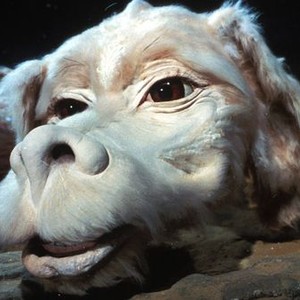There's probably no bigger cliche in movies than the power of imagination. After all, movies are a business and their purpose is to make money. Inspiration and creativity only play minor roles as we are subject each year to countless sequels of films that weren't very good. Of course, having good source material helps - the text was popular, so the project was greenlighted on the prospect of being profitable. The fact that it is one of the most enduring children's films of all time is simply a happy coincidence. I don't know anyone near my age who dislikes The Neverending Story.
We begin in Munich, although everyone in the film speaks English. Location is not particularly important. Bastian recently lost his mother. He is small for his age and spends most of his time drawing. His father tries to balance grief and obligation. He's also constantly tormented by school punks, always operating 3-on-1, and he doesn't have any means to fight back. He runs into a bookstore to evade the future thugs and starts a conversation with the owner, an old man who shares his love of books. The owner pushes the right buttons for Bastian, and soon the boy is "borrowing" a large tome with an orrin inscribed on the cover.
When Bastian finally gets to school, he is not only late but unprepared for a math exam. He blows off the class and hides in an attic that looks way too creepy for a middle school. He starts reading and is immediately engulfed in the world of Fantasia. The first scene introduces marvelous characters, including a huge, but well-mannered Rock Biter that still looks impressive to this day. No CGI involved. He and others are experiencing the disappearance (not destruction) of their homelands. They ascend on the Ivory Tower to meet with the Empress. She cannot help due to illness but she has sent for the great warrior Atreyu to help. When he arrives, he is a young man instead of the seasoned veteran they expected.
There is an immediate connection between the two boys despite Bastian's insistence that it's "just a story." Atreyu is bigger, stronger, and not afraid of anything - traits Bastian truly admires. When the warrior faces inevitable struggle and heartache, they experience it together. Bastian slowly becomes braver about facing his own life - reading about Atreyu does more for him than his well-meaning father's lectures. And he eventually realizes the reader is an integral part of the story.
Atreyu continues to meet fantastical creatures on his quest to save the Empress. He is being chased by a wolf-like creature called Gmork and there is nothing comical about him. Unlike other kids movies where the bad guys are incompetent, Gmork will rips the boy to shreds. The inclusion of this character likely bumped the rating to PG and certainly makes it too scary for some younger children. Atreyu gets hurt at times and you can see the blood. It is still a necessary part of this story - not just because of the source material, but without a real threat his bravery wouldn't mean much.
His greatest companion is his luck dragon, Falcor. His face is iconic to a generation of filmgoers. He shows up at Atreyu's worst moments and constantly reassures him that things will work out. There is no subtlety in any of the characters - everyone has a purpose for existence. Falcor represents good fortune, of course, and the importance of never giving up. And the Swamp of Sadness represents... you get the idea.
I've never thought of The Neverending Story as a children's movie. It's a great movie for kids to watch, but its appeal goes way beyond the delight of seeing all of these new creatures. The idea that dreaming is important is true for all ages... like the Gmork says "those without dreams are easy to control." Not subtle in the least, but it needs to be heard - now as much as then.
(Disclosure: The author Michael Ende hated the final project and demanded his name be removed from the credits. His right.)
